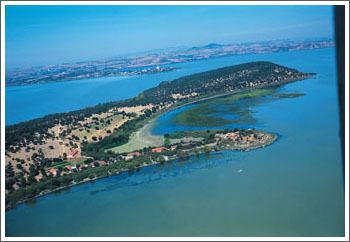Primary inflows Basin countries Turkey Islands 8 (Halilbey Island) Settlement Gölyazı | Primary outflows Ulubat stream Max. depth 10 m (33 ft) Inflow source Mustafakemalpaşa River | |
 | ||
Surface area 135 to 160 km (52 to 62 sq mi) | ||
k turkey travel bursa bursa neat little village golyazi lake uluabat
Lake Uluabat (Turkish: Uluabat Gölü and Apolyont Gölü) is the name of a freshwater lake in the vicinity of Bursa, Turkey. It is a large lake, covering an area of between 135 and 160 km2 depending on the water level, but very shallow, being only 3 m deep at its deepest point. The lake contains eight islands and one other that is sometimes an island and sometimes a peninsula. The largest island is known as Halilbey Island. In the southwest the lake is fed by the Mustafakemalpaşa River, which has formed a silty delta. Water leaves the lake by way of the Ulubat stream, flowing to the west, and reaches the Sea of Marmara via the Susurluk River.
Contents
- k turkey travel bursa bursa neat little village golyazi lake uluabat
- Map of Lake Uluabat Bursa Turkey
- Saint ConstantineEdit
- Important Bird AreaEdit
- References
Map of Lake Uluabat, Bursa, Turkey
Most shores of the lake are covered in submerged plants, and it has the most extensive white water lily beds in Turkey. Ulubat Lake is one of the breeding areas for the endangered pygmy cormorant (Phalacrocorax pygmeus). The latest DHKD (Society for the Protection of Nature Turkey) survey in June 1998 found 823 pygmy cormorant pairs, 105 night heron pairs, 109 squacco heron pairs, and 48 spoonbill pairs breeding on Ulubat.
The alternative name Lake Apolyont comes from the lake's greek classical name Apolloniatis (Απολλωνιάτις), from Apollonia-on-the-Rhyndacum (modern Gölyazı), an ancient Greek city situated on its banks which had considerable importance since it was on major trade routes.
Modern residential areas by its shores are Mustafakemalpaşa (formerly Kirmasti) and Karacabey (formerly Mikalick). The area was famous for centuries for its silkworm cultivation, but this industry has died out due to synthetic fabrics. The main industry today is fishing.
Saint ConstantineEdit
St. Constantine is a small island inside the lake. During the Byzantine era, there was a monastery of St. Constantine on the island. Today the island is uninhabited, but the monastery has survived Ottoman conquest of Asia Minor. The orthodox monastery has received attention from scholars because of its inscribed cross type with apses east and west.
Important Bird AreaEdit
The lake, which is in unprotected status, was declared by BirdLife International as an Important Bird Area in 1989 for its waterfowl species of international character and species, which are globally threatened.
